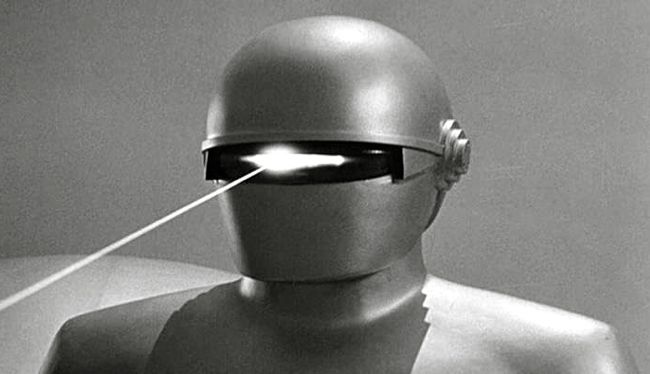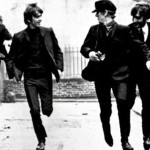
A world filled with fear. Nations hopelessly divided, on the brink of war. Nuclear arms in the wrong hands, at the ready. Enter, from the skies, a starship bearing a savior, his robot and a promise of global peace via a fail-proof solution to war.
Answered prayers? Certainly not in Hollywood’s 1951, when the alien peacemaker, Klaatu, was duly hunted down and slain. Not in the real-life 1950s, either, when Robert Wise’s “The Day the Earth Stood Still” terrified much of its audience with images of the robot enforcer Gort. Today, wistful viewers might ask: Where are Klaatu and Gort when we need them most?
The original “The Day the Earth Stood Still” had no peers or antecedents — it was a giant step forward for science fiction, which had been pretty much a boys’ genre since Georges Melies’ “A Trip to the Moon” in 1902. Wise’s movie introduced the concept of science fiction films for adults.
On Blu-ray, “The Day the Earth Stood Still’s” black-and-white images soar. While plenty of grain remains, the movie plays out across an elegant gray scale. The blacks are strong and supple — take a look at the detail in some of the Afro-American faces in the UFO area’s crowd scenes. There are dramatic hard contrasts at work in the noir-ish night scenes — watch for the genre’s usual backlit blinds. For b&w and Blu-ray, this could be the start of a beautiful friendship.
The high resolution and detail cut both ways. The robot Gort’s costume, for example, shows a good many wrinkles (but the detail on his master’s get-up is gorgeous). The process shots can’t sell those taxi rear window images in an HD world.
The Blu-ray’s DTS HD Master 5.1 audio seems too good to be true, such as when the space ship arrives and the subwoofer rattles viewers’ bones. This seems to indicate the original audio has been given some help. Purists should switch over to the mono track. Dialog is clear, strong.
The new making-of documentary (in HD) tightens and improves upon the one offered on the 2003 DVD. Both are good and tell pretty much the same stories. Actress Patricia Neal and ex-child star Billy Gray are among the witnesses.
“Science Fiction as Metaphor” digs into the film’s political content, such as the idea that the robot served as a stand-in for the U.N. The movie was a contemporary to the McCarthy witch hunts and the Rosenbergs’ trial.
The political framework, essential to understanding the film, is discussed throughout the extras.
A strong believer in UFOs and a passionate opponent of nuclear weaponry, Wise seemed the perfect choice to direct.
“It was a marvelous way to get a message to the world,” the director says on the commentary track he shares with pal Nicholas Meyer. Their talk has been ported over from the older DVD.
Studio mogul Darryl Zanuck, hardly a dove, saw the film only as good entertainment.
Zanuck nonetheless backed Wise when co-star Sam Jaffe came under attack for his left-wing politics. Jaffe, who plays the Einstein figure, was perfect for his part, finger-in-socket hair and all.
Wise says he was unaware of the Christ references when he made the movie, though, as Meyer points out, they are pretty hard to miss. Screenwriter Edmund H. North gave the alien the alias of Carpenter. He is betrayed by a stuffed-shirt Judas, killed by the government as preaches peace, and is resurrected from the dead. (Censors demanded that the resurrection be temporary and that God’s powers of eternal life must be mentioned by Klaatu upon revival.)
The Klaatu role seemed destined for Spencer Tracy or Claude Rains, but Zanuck ultimately decided that a newcomer was needed to sell the otherworldly being (imagine Tracy walking out of a flying saucer). From London came the tall and elegant Michael Rennie, with his angular features and piercing eyes.
Rennie’s pals Neal and Hugh Marlowe took the other main adult roles, with Gray playing the kid who befriends and understands the alien as he masquerades as a human. “I try to associate myself with the film the most I can,” Gray says these days.
A new commentary comes from a quartet of film and soundscore historians. Bernard Herrmann’s score can be accessed as an isolated track. The theremin musician Peter Pringle surveys the electronic instrument and gives a performance of Herrmann’s title theme. There’s also a Blu-ray toy that simulates playing the instrument.
The story’s creator, fantasy magazine specialist Harry Bates, merits a short feature. Interesting career; sad ending. Bates’ original story “Farewell to the Master” is read aloud elsewhere on disc 2 and certainly stands up on its own — fun if you have the time.
“Edmund North: The Man Who Made the Earth Stand Still” is a touching tribute to the screenplay writer, who gets a “based on” credit in the new movie. One of his great creations — the line “Klaatu barada nikto” — comes from the name of an L.A. street, like so many other things in the movies.



Leave a Reply